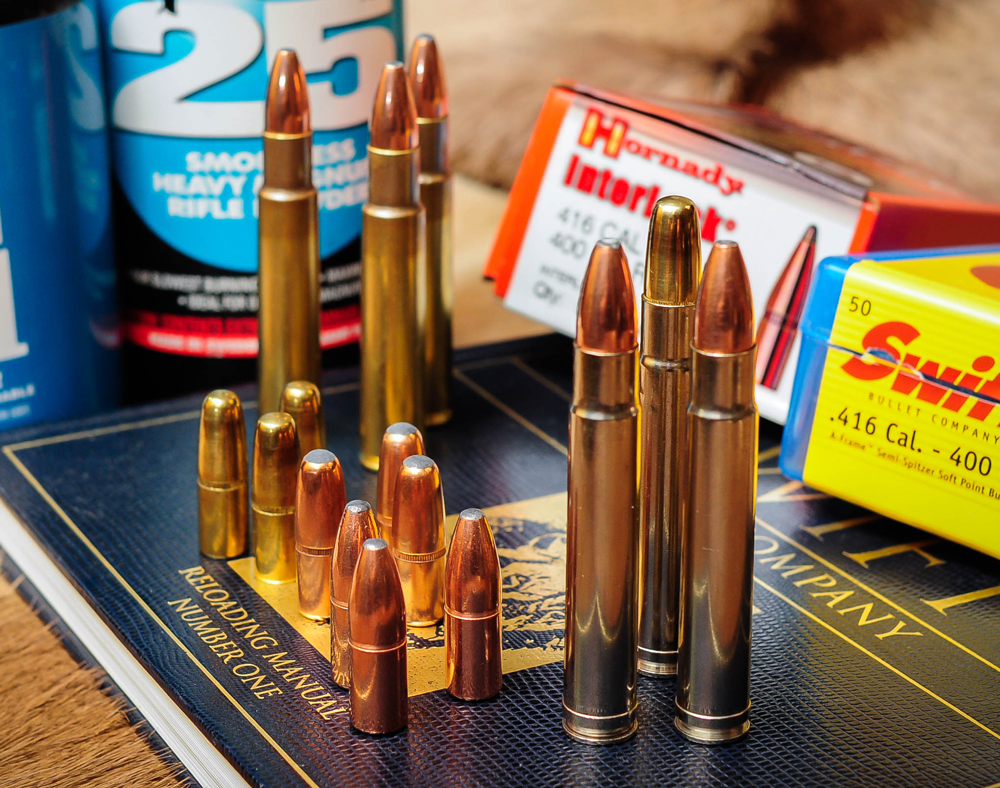At GunDigest, we independently review products. However, we may earn a commission when you purchase through links on our site. Learn More
Reloading Ammo: Dangerous Game Loads — Part I

Some shy away from producing dangerous game loads themselves, but this may be a mistake. Find out why you should load your own if heading on safari.
I’m just back from a fantastic African Safari, and thought we’d discuss some of the reloading points for Dangerous Game cartridges. I’ve had people tell me that I was crazy for using handloaded ammunition on a Dangerous Game hunt. I totally disagree with that statement; in fact, I believe the opposite to be true: dangerous game loads are among the most reliable.
Let’s be honest, factory ammunition is better than it ever has been. And, I think factory ammunition offers a wider variety of choices than ever. That said, there are times where cost or availability makes handloading the logical choice.
“I’d never use anything but the best factory ammo on safari; handloads just aren’t dependable.”
I say nonsense. When you’ve gained enough confidence as a handloader, the big bore ammo will make your reloading bench shine, first in cost reduction, then in performance.
The attention to detail that you can provide simply cannot be equaled by a machine, no matter how well it was designed. People ask the usual questions like “Well, what if you get a bad primer?” The primers come from the same factories that make the ammo, so I feel that’s a moot point. Load enough ammunition and you will get a bad primer (I’ve had very few), and I’ve experienced more failures-to-fire with factory stuff than I ever did with my own loads.
While the bullet choices are really good among today’s factory ammo, they can’t cover everything. An example: On this recent safari, I was using a Heym bolt-action .404 Jeffery, and I wanted to shoot the Woodleigh Hydrostatically Stabilized solids. Problem — no factory loads exist with this combination. Solution — I handloaded those funky Woodleigh bullets in to Norma .404 cases over 80.0 grains of Reloder-15, and, voila! 2,280 fps, MOA accuracy, and all performed well in Africa, even on elephant.
Depending on your choice of big bore caliber, factory ammunition can be very expensive. The popular .416 Rigby, which makes a very effective hunting round, comes at the average cost of $100-200 per box of 20. That can be a wallet breaker, especially if you need to try several different brands in order to find what your rifle likes.
Dangerous game loads will not only let you tailor the loads to the rifle, but do so at a third of the price. The cost savings can be put toward more practice with the big stick, so when the trophy of your dreams presents itself, there’s no worries. The more popular .375 H&H is a bit more affordable, but the larger and more obscure calibers are even more costly. The .470 NE can be as much as $17 per round!
The reloading technique for Dangerous Game cartridges is the same, with the exception of the crimp stage. If you’re shooting one of the ‘straight-walled’ cartridges, like the .458 Winchester Magnum, .458 Lott or .458 Express, you’ll definitely want a good roll crimp to keep those bullets in place under recoil.
The same can be said for any of the double rifle Nitro Express cartridges. Sometimes you’ll find that you shoot the right barrel much more than the left, and the cartridge in the left barrel can be exposed to multiple rounds of recoil, which may force the bullet out of the case were it not heavily crimped. This is especially true if you use the solid/soft bullet combination in your double.
Seating depth can be manipulated in handloads for safari, and sometimes a few thousandths can mean the difference between your bolt-action rifle feeding a particular bullet well or having feeding issues.
You really don’t need to wring every last bit of velocity out of your big bore either. Handloaders are always chasing velocity, when compared to the advertised factory velocities, but often you’ll find the best accuracy a bit below those numbers.
My .404 shoots MOA with those 400-grain bullets at 2,280 fps, instead of the modern load of 2,350 fps, and I’m quite alright with that. The elephant wasn’t, though. Same can be said for the .375 H&H; it will still perform very well (some say better) if you drop the velocity by 100 – 150 fps. Don’t sweat the velocity loss from canister-grade powders.
Try dangerous game loads for your big bore, you’ll gain confidence as you see how well your ammunition performs. I’ve been on five safaris to Africa, and I’ve never pulled the trigger on factory ammunition while there. 14 species later, I’ve had no issues whatsoever.
Next Step: Get your FREE Printable Target Pack
Enhance your shooting precision with our 62 MOA Targets, perfect for rifles and handguns. Crafted in collaboration with Storm Tactical for accuracy and versatility.
Subscribe to the Gun Digest email newsletter and get your downloadable target pack sent straight to your inbox. Stay updated with the latest firearms info in the industry.